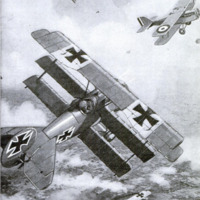Von Richthofen's three-decker Fokker fighting-plane
Contenuto
-
Titolo
-
Von Richthofen's three-decker Fokker fighting-plane
-
Article Title and/or Image Caption
-
Fighting in a Three-Decker Airplane. Fokker produces a fast triplane in von Richthofen is killed
-
Caption: It was in this formidable-looking three-decker Fokker fighting-plane that von Richthofen, the greatest of German airmen, flew to his death. On this Fokker triplane head-on resistance has been cut down by eliminating all wires, and by a new form of landing wheels, mere disks of a stream-line design. Some day an inventor will provide a landing gear that will fold back like a bird's legs. At the moment, the birds are still one hop ahead in this respect
-
extracted text
-
VON RICHTHOFEN, the German
flyer who had moro victories to
his credit than any other living or
dead rival, was killed in a _triplane.
Tt wan u Fokker of & now type, which tho
German army had rejected, but which
von Richthofen thought was well worth
trying. The Fokker Js not the first tri-
plane.” Both Roe in England and Curtiss
in America had experimented with the
type before the European war. Why
did Gormany's best flyer select a typo that
had boon discredited
The two lower surfaces of a triplane
do not give as much Iift as they would if
there wero no third plane above them,
while their drift—in other words, ro-
sistance against. propulsion-—is the same,
"Then, why does the triplane ides persist?
Beewise triplancs aro stronger than
biplanes of the same surface and weight,
By sacrificing some of this. inherent
strength, Fokker made striking improve-
ments possible.
Obviously, triplanes contain a large
surface area within a small span of
wings. The entire surface clowly wur-
rounds tho load It has to wpport. In a
fighting plane, above all, the load must
bo condensed In order to oppose n
minimum resistance to the tums and
twists that occur in aerial ducing.
‘Now, what did Fokker do? He turned
the framing of the wings, the hollow, box-
shaped beams, and the deop-wobbed ribs
into u truss. Like a bridge, this structure
necded no external bracing wires. The
framing was tucked away betwoen the
smooth upper and under surfaces of the
wings. A single light strut, thin and
sharp #0 that its air rsistanco negligible,
alines rather than braces the triple wings
on ach sido. The absence of bracing
struts and cables reduces the machine's
head-on resistance so much thatthe
triplane as u whole became us efficient
as a biplane.
‘The commercial flying-machine of the
future will probably be a triplane, be-
cause we need compact machines in our
cities. The military machine of the
future may also be a triplane, because its
small span permits quick maneuvering.
The greater the span, the greater
the difference in speed between the two
sides of a quickly turning airplane. As
this difference must not exceed a safe
limit, the triplane, with its smaller span,
is obviously preferable. A small span
accelerates turning.
The triplane’s ability to maneuver
quickly was the reason why it became
von Richthofen’s tool in a duel in which
sudden turns are paramount.
Surface can be piled on surface and
certain specifically military advantages
obtained. From below and from above,
multiplaned machines offer a smaller
target. They are safe even after one of
the wings has been badly damaged. In
a Fokker triplane Captain Boelke would
have survived the accident—the tearing
away of part of a wing in a collision—that
was fatal to him in his Fokker monoplane.
It is a small step from a triplane to a
quadriplane or multiplane. The greater
the number of planes that are super-
posed, the less relatively important be-
comes their reduced efficiency in compari-
son with their structural advantages.
The Fokker triplane is really a quadri-
plane. Fokker turned the under frame
supporting the landing and starting
wheels into a fourth wing. He could
give considerable depth and area to this |
wing, in spite of its necessarily small
span. . The wheels were disks, forming |
flanges on each side. This gave to the
underframing a certain lifting power,
which compensated in a measure for its
unavoidable resistance. This fundamen-
tal improvement will probably beadopted.
Such a machine has a great speed-
range and stupendous climbing power. |
If it attacks the air at a steep angle it |
will have great lift at low speed, thus |
robbing the ‘“airhole” of its terrors and |
making turning easy while climbing fast.
-
Autore secondario
-
Carl Dienstbach (writer)
-
Lingua
-
eng
-
Data di rilascio
-
1918-09
-
pagine
-
386-387
-
Diritti
-
Public domain
-
Archived by
-
Filippo Valle
-
Alberto Bordignon (Supervisor)


